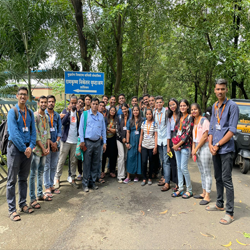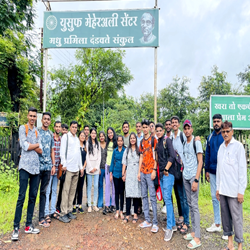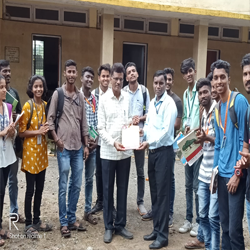Rural Development
- ABOUT DEPARTMENT
- DEPARTMENT FEATURES
- COURSE INTRODUCTION
- PROGRAMMES OFFERED
- SYLLABUS
- DEPARTMENT ACTIVITIES
- SUPPORT STAFF
- STUDENT ACHIEVEMENT
- ILLUSTRIOUS ALUMNI
- SRUJAN
Department of Rural Development is one of the most active departments at Kirti College since academic year 1977-78. The department tries to cover all the aspects of the topics prescribed in the syllabus and ensures its applicability. Through field visits and guest lectures, the subject comes alive to students and kindles their urge towards learning.This subject is an interdisciplinary subject of Civics, Political Science, Geography, History, Economics, Agricultureand many more. The subject make student aware about the agricultural growth & de-growth and its importance in rural economy also it make students friendly about the working of Local Self-Government Institutions & Co-operative sector.
The student centric activities-
Class Presentations by the students on co-curricular subjects
Competitions- Elocution/Quiz/Debates/ PPT / Poster making
Felicitation of Meritorious Students
Model Youth Parliament
Open House – Samvaad, Futuristic Fridays
Saturday Guidance Series- Footsteps
Study Tours –Alibag, Silvassa, Ralegan Siddhi, Hiwre Bazar
Field Visits to Samyukta Maharashtra SmrutiDalan,American Centre Library, National Museum of Indian Cinema, Vidhan Sabha
Over three Under Graduate years, students study nine papers in Rural Development. They study One, Two & Six papers in First, Second & Third year respectively. The students delve into concepts, approaches and ideologies to understand the basics of the subject.
| Semester | Paper No. | Paper Name | Unit No & Name |
|---|---|---|---|
| Semester – I | Paper No. I | Introduction to Rural Development | Unit-1: Rural Development
|
| Semester – II | Paper No. I | Issues Related to Rural Development | Unit-1: Democratic Decentralization and Revenue Administration in Maharashtra
|
| Semester – III | Paper No. II | Rural Society | Unit-1: Indian Rural Society
|
| Semester – IV | Paper No. II | Development Strategies | Unit-1: Study of Agriculture Policies
|
| Semester – IV | Paper No. III | Laws Related to Rural Development | Unit-1: Law Related to Panchayat Raj in Maharashtra Historical background Mumbai gram panchayat act 1958 Maharashtra zilla parishad & panchayat samiti act 1961 73rd constitutional amendment Unit-2: Land Reform Legislation Land holding & land reforms Tenancy act Land calling act Consolidation of land holding act Unit-3: Law Related to Rural Development Employment guarantee scheme (Maharashtra state) Sanitation campaign Drinking water scheme Right to information act Unit-4: Law Related to Natural Resources Maharashtra water irrigation act Maharashtra forest conservation act Social forestry act Maharashtra soil conservation act |
| Semester – V | Paper No. IV | Agriculture and its Significance in Rural Development | Unit-1: Agriculture Definition – History – Nature – Feature of Agriculture Scope and Role of Agriculture in Indian Economy Causes of Low Agricultural Productivity in India and Measures to Increase Agricultural Productivity Unit-2: Land Constituents of Land and its Natural Characteristics and Types of Soil Soil Erosion – Types – Causes, Consequences – Remedial Measures Soil Testing – Need, Importance in Agriculture Unit-3: Significance of Inputs in Agriculture Seeds – Traditional and Non-Traditional and its Importance Types of Fertilizers and Pesticides, its Importance and Consequences Agricultural Equipment – Traditional and Non-Traditional Unit-4: Farm Business Management Meaning, Objectives, and Nature Principles of Farm Business Management Factors of Agricultural Production |
| Semester – V | Paper No. V | Rural Marketing and Finance |
Unit-1: Rural Marketing Concept and Characteristics of Rural Marketing Scope and Significance of Rural Marketing Problems of Rural Marketing and Remedial Measures Unit-2: Agriculture Marketing Concept, Nature, and Types of Agricultural Marketing Functions of Agricultural Marketing Significance of Agricultural Marketing in Rural Development Unit-3: Marketing Risks and Uncertainties Features of Agricultural Products Concepts of Marketable Surplus and Marketed Surplus – Causes of Low Marketed Surplus Risks and Uncertainties – Types, Remedial Measures Unit-4: Agencies in Agricultural Marketing Marketing Intermediaries Agricultural Agencies: 1. Food Corporation of India (FCI) 2. Agriculture Produce and Marketing Committee (APMC) 3. National Agricultural Cooperative Marketing Federation (NAFED) |
| Semester – V | Paper No. VI | Applied Agriculture |
Unit-1: Applied Agriculture Definition, Nature, and Scope Significance of Allied Activities in Applied Agriculture Its Significance in Rural Development Unit-2: Agro-Ecology Definition, Nature, and Scope Zero Budget Farming and Bio-farming Mixed Cropping Pattern Unit-3: Horticulture Concept and Nature of Horticulture Significance of Horticulture and Floriculture in Rural Development Various Techniques and Factors of Horticulture Unit-4: Forestry Concept and Types of Forestry Importance of Forestry Government Role and People’s Participation to Promote Forestry |
| Semester – V | Paper No. VII | Rural Resource Management |
Unit-1: Rural Resources Concept of Resources – Types of Resources Renewable Resources, Non-renewable Resources Need for Conservation of Resources Unit-2: Land Formation of Land, Features of Land, and Land Use Pattern Conservation and Quality of Land Measures for Land Development Unit-3: Water Resources Concept of Water Resources, Distribution of Water, Properties, and Importance Scarcity of Water, Measures for Water Scarcity Water Conservation, Government Schemes Unit-4: Solid Waste Management Concept of Bio Waste, Solid Waste, History Problems of Solid Waste and Consequences Management of Solid Waste – Types, Sources, Methods |
| Semester – V | Paper No. VIII | Emerging Issues in Rural Development |
Unit-1: Rural-Urban Regional Imbalance Provisions for Rural Development in Five-Year Plans Negligence of Rural Development Present Status of Rural Development Unit-2: Co-Operative Sector Concept and Importance of Co-operative Sector Types of Co-operative Societies Causes of Decline of Co-operative Sector and Remedial Measures Unit-3: Shrinking of Agricultural Land Acquisition of Land for Infrastructure Development, Housing, and SEZ Impact of Acquisition of Land on Farmers Project Affected People’s Movement Unit-4: Water Pollution Causes of Water Pollution Impact of Water Pollution Remedial Measures to Control Water Pollution |
| Semester – V | Paper No. IX | Social Work for Rural Development |
Unit-1: Voluntary Sector Concept of Voluntary Work – Volunteer, Voluntary Organization, and Its Various Types Nature of Voluntary Sector Features of Voluntary Sector Unit-2: Emergence of Voluntary Sector Emergence and Development of Voluntary Sector in India with Special Reference to Maharashtra Role and Significance of Voluntary Sector Principle and Practices of Management of Voluntary Sector Unit-3: Activities of Voluntary Sector Principal Activities of Voluntary Organization Key Issues Before Voluntary Sector N.G.O. and People’s Participation Unit-4: Registration Process of Non-Government Organization Laws Regarding Registration of N.G.O. Requirements of Documents for Registration Revenue Sources and Expenses of N.G.O. |
| Semester VI | Paper No. IV | Agriculture and its Significance in Rural Development |
Unit-5: Review of Agriculture Policies Green Revolution – Concept, Principles, Consequences and Evaluation Green Revolution Pre and Post In the Era of Liberalization Policy 1991 and Onwards Unit-6: Agricultural Education Extension and Research Indian Council of Agriculture and Research (ICAR) Role of Agricultural Universities and Krishi Vigyan Kendras (KVK) Structure and Functions of Department of Agriculture – Govt of Maharashtra Unit-7: Recent Trends in Agriculture Sustainable Agriculture Organic Farming Green House and Tissue Culture Unit-8: Agricultural Related Activities Group Farming – Concept and Importance Food and Fruit Processing Industries – Nature and Importance Women Participation in Agricultural Sector |
| Semester VI | Paper No. V | Rural Marketing and Finance |
Unit-5: Rural Finance Rural Finance – Concept, Nature and Types Rural Indebtedness – Causes, Consequences and Remedial Measures Sources of Rural Finance – Institutional and Non-Institutional Unit-6: Financial Institutions Co-operative Financial Institutions – PCCS, DCCB, and SCCB Role of NABARD in Rural Development Regional Rural Banks Unit-7: Micro Finance Concept, Origin and Scope of Micro Finance Significance of Self Help Group in Rural Development Self Help Group – Bank Linkages Unit-8: Problems of Rural Finance Problems Related to Agriculture Credit Supply Remedial Measures and Promotion of Rural Credit Crop and Livestock Insurance and Its Importance |
| Semester VI | Paper No. VI | Applied Agriculture |
Unit-5: Animal Husbandry Concept and scope of Animal Husbandry – Goat, Sheep, Cattle, etc. Significance of Animal Husbandry in rural development. Low productivity of Indian cattle – Causes and Measures. Unit-6: Poultry Concept and Essential Factors of Poultry Farm. Significance of Poultry Business in Rural Development. Government Schemes for Promotion of Poultry Farming. Unit-7: Fishery Concept, Nature, and Scope of Fishery. Various Types of Fishery and Government Schemes for Promotion of Fishery. Significance of Fishery in Rural Development. Unit-8: Processing of Agro-Allied Products Concept and Nature of Processing of Agro-Allied Products. Types of Agro-Allied Products. Importance of Processing of Agro-Allied Products. |
| Semester VI | Paper No. VII | Rural Resource Management |
Unit-5: Human Resources Concept and Nature of Human Resources. Factors of Human Resource Management. Population Explosion – Education, Health-Related Problems. Unit-6: Development of Infrastructure Transport and Communication (Electronic Media). Rural Housing and Rural Electrification. Water Supply and Pure Drinking Water. Unit-7: Science and Technology for Rural Development Use and Importance of Technology for Rural Development. Issues Regarding Use of Science and Technology in Rural Regions. Role of Information Technology in Rural Development. Unit-8: Rural Energy Resources Concept, Importance, and Scope. Traditional Rural Energy Sources and Their Limitations. Non-Traditional Energy Sources. |
| Semester VI | Paper No. VIII | Emerging Issues in Rural Development |
Unit-5: Land Pollution Concept and Various Causes of Land Pollution. Consequences of Land Pollution. Remedial Measures for Land Pollution. Unit-6: Pressure of Population on Agricultural Land Concept and Types of Rural Unemployment. Causes and Consequences of Sub-Division and Fragmentation of Land. Migration – Types, Causes, and Remedial Measures. Unit-7: Rural Poverty Concept of Poverty. Causes and Consequences. Remedial Measures. Unit-8: New Economic Policies and Its Impact LPG as Manifestation in New Economic Policy. Impact on Agriculture and Rural Area Artisans. Opening of Rural Areas to Capitalist Classes in Banking and Marketing. |
| Semester VI | Paper No. IX | Social Work for Rural Development |
Unit-5: Professional Social Work Concept, Definition, Characteristics, Objectives. Steps of Social Work. Social Worker – Approach, Skills, and Techniques. Unit-6: Scope and Field of Social Work Field of Social Work – Primary and Secondary. Family Welfare, Child Welfare, Youth Welfare, Women Welfare, and Welfare of the Aged and Handicapped, Community Development. Medical Social Work, Labour Welfare, Crime and Correctional Services. Unit-7: Principle and Method of Social Work Case Work and Group Work. Community Organization. Social Work Research, Administration, and Management in Social Work. Unit-8: Social Research Concept and Features of Social Research. Importance and Motivating Factors of Research. Report Writing. |
- Field visits – Due to practical base study method, the department organizes study and field visits to have an insight of syllabus at every stage of UG program.
- Srujan mohotsav – The department takes initiative to organize a guest lecture on occasion of srujan mohotsav.
- Faculty change program – The subject expert of the other college visits and conducts lecture for student of Rural Developemnt.
The Department hasmore than 95% passing rate at the TYBA examinations with meritorious students securing rank in top three positions at the College level every year.
The M.Phil degree has been awarded to three students of department by University of Mumbai.
| SR. NO. | NAME | DESIGNATION |
|---|---|---|
| 1 | Dr. D V Pawart | Principal of Kirti College |
| 2 | Prof. Nitin Kharat | Assistant Professor at Kirti College |
| 3 | Prof. Gaurav Raut | Assistant Professor at Kirti College |
| 4 | Mr. Shubham Sonavane | Assistant Registrar at SNDT University |
Faculty
 Dr. Nitin V Kharat
Dr. Nitin V Kharat
Associate Professor and H.O.D
M.A, M.Phil, PhD
Dr. Ankita Vartak (CHB)
Assistant Professor
M.A, PhD
Dr. Gaurav Raut
Assistant Professor
M.A, NET, SET, PhD










